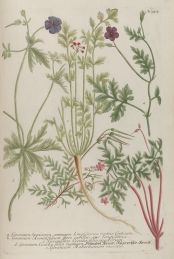Crucial Cranesbill
By Audrey Stallsmith

Blue as the evening sky, blue as cranesbill flowers, blue as the lips of drowned men and the heart of a blaze burning with too hot a flame.
Inkdeath--Cornelia Funke
The hardy geranium, better known as cranesbill, is one of my favorite plants--for good reason. Not only is it attractive, both in and out of bloom, but it is also well-nigh indestructible. Although the severe winter this year killed off some of my less robust perennials, the cranesbills just seemed to find all that cold stimulating!
These are not, of course, the annual bedding plants that many people know as geraniums. Although distantly related, the annuals actually belong to the genus Pelargonium.
Their upper petals tend to be a different shape than their lower, but the five petals on true geranium blooms are all cut from the same pattern. And, while species of cranesbill grow in some of the most frigid parts of the world, pelargoniums originally came from South Africa and must be more tenderly treated.
Geranium derives from the Greek geranos ("a crane") because the seed is, as John Gerard points out, "set together like the head and bill of a bird." Other nicknames for the plant include Herb Robert, alum root, doves' foot, pigeons' foot, chocolate flower, old maid's nightcap, and shameface.
Herb Robert, named after a saint, generally refers specifically to Geranium robertianum and doves' foot to columbinum. The type that grows wild at the edge of woodlands here in PA is maculatum, AKA "spotted" geranium.
Although Louise Beebe Wilder describes Geranium macrorrhizum as, "warmly and pleasantly scented" the leaves of most hardy geraniums are what we will politely term "musky." Wilder calls Herb Robert's fragrance "most unendurable. . .for when bruised or broken it fills the world with expostulations in the form of a nasty odour which clings to clothing and hands for a long time."
Even so, she admits to allowing some of the ferny-foliaged plants to stay because they are "so pretty and altogether amusing." I must confess that I do the same, even though "stinking Bob" has become a pervasive weed in my garden. Perhaps due to its "sad" odor, the geranium stands, in the Language of Flowers, for "I shall never see him," "melancholy," and "recall." Fortunately, most of the species do not emit any odor at all unless they are crushed.
The "alum" in one of its nicknames probably refers to the astringency of hardy geranium's roots. Herbalists have employed those roots in the past to "cure miraculously ruptures or burstings. . .and the decoction of the herbe made in wine, prevaileth mightily in healing inward wounds. . ." (Gerard) That astringency has also made hardy geranium a popular cure for diarrhea, dysentery, and cholera.
But the plant's main asset must remain its attractive appearance and endurability. I tend to prefer the types with dark-centered or veined flowers. Some of my favorites include 'Ballerina,' 'Buxton's Blue,' 'Patricia,' psilostemon, and 'Splish-Splash.' But I should warn you that once hardy geraniums sink their tenacious roots into your heart, you also are probably going to find them too "pretty and altogether amusing" to eradicate!
Hardy geraniums image is from Phytanthoza Iconographia, courtesy of the Missouri Botanical Garden








